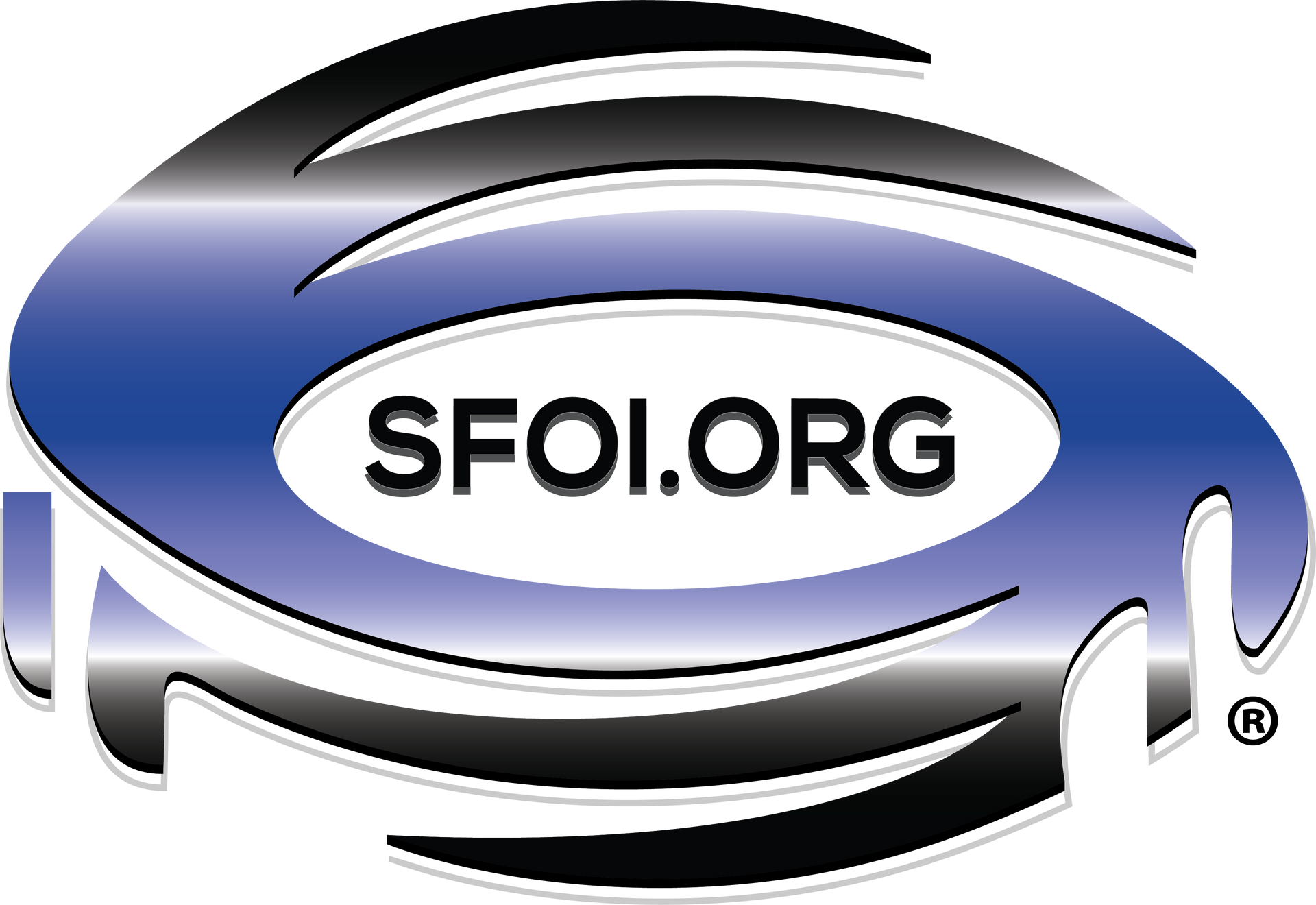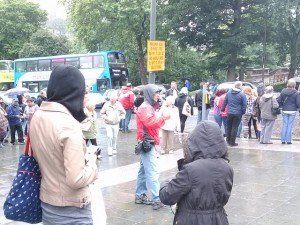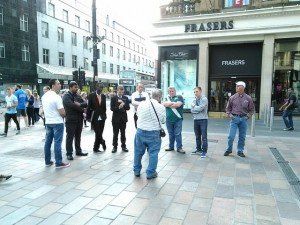Jesucristo es el Evangelio: su persona y su obra.
El Evangelio o Buena Nueva trata de la persona y obra del Dios hombre, el Señor Jesucristo, quien fue enviado al mundo para dar a conocer a su Padre y reconciliarnos con su Padre para que podamos habitar juntos y conocerlo, lo cual se llama vida eterna (Juan 17:3).
Las Escrituras enseñan que nuestros primeros padres, Adán y Eva, pecaron, es decir, transgredieron la ley de Dios, en el Jardín del Edén al comer del árbol del conocimiento del bien y del mal (Génesis 3:1-6). Este acto les permitió recibir el fruto de la semilla de ese árbol, que es la incredulidad que conduce a la anarquía (Génesis 3:7-13).
This lawless state became their nature and that is why they are called sinners since sin defines their inner nature. As sinners all of their children and everyone born since then is born with their sin nature (Romans 5:12-21). To be born with a sin nature means you are born separated from God and at enmity with Him.
The evidence of this is that we sin from within the depth of our souls [i.e. worship other gods (idolatry), taking God’s name in vain, lie, steal, lust, covet, murder (even in our hearts and mind - Matt 15:18-19; Mark 7:20-22; Luke 6:44-46) (Col 3:5-9)]. Every sin committed pushes us further away from the living and true God and hardens our heart towards Him.
Something outside of ourselves had to happen to change our nature and therefore reconcile us to God. That something was God, who dwells in unapproachable light (I Timothy 6:15-16) , sending of His Son, the Light (John 8:12) and Life (Matt 6:32-33, 6:51) of the world, into the world to shed His blood for the forgiveness of our sins (Luke 24:47). He was raised from the dead for our justification (Romans 5:1) and He ascended into heaven so the Holy Spirit could be sent to those who believe (Luke 24:49-53; Acts 1:4-9). Through this process did Christ bring about our new birth (John 3:1-8).
This means that by the forgiveness of our sins, etc. we are reconciled to God and being born anew (John 3:1-8) means that our nature is no longer a sin nature but we are given a divine nature (2 Peter 1:4). This divine nature is God’s nature and is passed to us since He has become our Father. Thus we are new creatures who long to know our God whom we now call Father more intimately.
The Scriptures list several purposes of His presence:
To reveal God to us: ( Col 2:9 )
Para reconciliarnos con el Padre: ( 2 Cor. 5:19 ).
Para morar con nosotros en esta vida para que podamos conocerle (Juan 17:3)
Para enseñarnos los caminos del Padre: ( Juan 7:15-18 )
To show us the will of the Father: ( John 6:38 )
To send the Holy Spirit that reveals God to us ( I Cor. 2:10-12 )
To send the Holy Spirit that will raise us from the dead ( 2 Cor 4:13-15 )
To provide every spiritual blessing ( Ephesians 1:3 )
To make me accepted in the beloved (Ephesians )
To adopt me into the family of God ( Ephesians 1:5-7 )
To provide redemption, forgiveness and a knowledge of His will ( Ephesians 1:7-10)
To seal us with the Holy Spirit ( Ephesians 1:13-14 )
To provide the circumcision without hands ( Colossians 2:11 )
To purge our sins ( Hebrews 1:3 )
To intercede for those who are His ( Romans 8:34 ; Hebrews 7:25 )
To speak to us in these last days ( Hebrews 1:1-2 )
To fulfill Moses prophecy (
Deuteronomy 14:15 )
Como ministerio evangelístico SFOI enfatiza la salvación de los pecadores y que la fe viene por el oír (Rom 10:17) y que algunos siembran, algunos riegan, pero Dios da el crecimiento (I Cor 3:6).
La SFOI comienza con el hombre muerto en pecado (Efesios 2:1) y, por lo tanto, necesitado de ser resucitado o nacido de nuevo (Juan 3:3-6) por el Segundo Adán, el espíritu vivificante (1 Corintios 15:45; Efesios 2:5), quien resucita el alma de entre los muertos a una nueva vida (2 Corintios 3:6, 15:17-18; Romanos 6:4). Así, la conversión de muerte a vida ocurre por la fe en la Palabra de Dios (Romanos 10:17; 1 Pedro 1:23).
Thus the Gospel is:
La Buena Nueva del Padre enviando a Su Hijo (Mateo 3:17, 17:15, Marcos 1:11) Jesucristo (1 Juan 4:2-3, 4:15, 5:1) al mundo para salvar a los pecadores (1 Juan 3:5, 4:14) de Su ira para que el pecador por fe en la persona y obra del Hijo recibiera perdón y cobertura de sus pecados para ser reconciliado con el Padre (2 Cor 5:18-19) y tener vida eterna con Él.
This wrath abides upon each individual sinner which at the sinners physical death will come upon them forever ( John 3:36 ; Eph 2:3 , 5:6 ; Col 3:6 ; I Thess 1:10 , 2:15-16 , ). Every soul is born into this world with a sin nature ( Psalm 51:5 ) and is thereby alienated from God all of their life until or unless they repent of their unbelief and turn to the Lord Jesus Christ for the forgiveness of their sins and reconciliation with the Father.
Así, el Padre, en la plenitud de los tiempos (Gálatas 4:4), envió a su Hijo unigénito, Jesucristo, al mundo para lograr la salvación de las almas arrepentidas (Tito 3:4-7). Mediante todos los aspectos de su vida, muerte, resurrección y ascensión, Jesús cumplió todos los aspectos necesarios para la salvación de los pecadores arrepentidos (Romanos 3:2; Hebreos 2:17; 1 Juan 2:2; 1 Juan 4:10). Por lo tanto, solo por la fe (Romanos 1:17; Gálatas 3:11) en Jesucristo solo (Juan 8:24; Hebreos 5:9, 7:28, 9:11-15, 9:24-26, 10:9-18; 1 Juan 4:9, 5:11-12; Tito 2:11-14) un alma pecadora arrepentida se reconcilia (2 Corintios 5:18-19) con el Dios vivo.
Upon calling upon the Name of the Lord ( Romans 10:9-10 ) for the forgiveness of their sins the soul is declared righteous (the just life by faith), receives the Holy Spirit ( Acts 2:38 ) as an earnest deposit of their expressed faith, enters the Kingdom of God ( Heb 12:22-24 ), lives a life of following Christ’s teaching (this is called sanctification Hebrews 2:11 ; Titus 2:14 ; I John 5:3 ) and when the sinner who is now called a Saint dies the Holy Spirit will raise them from the dead into the Father’s presence (this is called glorification).
The purpose of this great salvation, which is called eternal life, is that souls would come to know their creator, the true and living God and worship and enjoy Him forever.
Jesus sums this up in John 17:3, “This is eternal life, that they may know You, the only true God, and Jesus Christ whom You have sent.”
The Goal of SFOI
The goal is for lost souls at major sporting events to be reconciled to and know God ( John 17:3 ).
The means of the goal is explained here:
El objetivo de SFOI es que los fanáticos que asisten a los principales eventos deportivos escuchen el Evangelio de nuestro Señor Jesucristo (Fil. 1:18; Romanos 10:1-17) y sean llamados a arrepentirse y creerlo.
Al aficionado se le presenta la oportunidad de responder al Evangelio, lo que incluye hacer preguntas al evangelista y ser ministrado en el momento en función de su respectivo lugar con el Señor.
Thus the SFOI evangelist both preaches the Gospel and ministers to the fans as they respond and hopefully is able to refer the fans to a Bible teaching church for discipleship. [ Acts 2:38 , 3:19 , 5:31 , 8:22 , 17:30 , 20:21 , 26:20 ; 2 Cor. 7:10 ; 2 Peter 3:9 ; Rev. 3:19 ]
Los aficionados escuchan el Evangelio mientras participan en los eventos previos al partido, ya sea en la sede respectiva o en un festival de fans**, quizás ubicado en el centro de la ciudad anfitriona. En otras palabras, los aficionados no están dentro del estadio cuando escuchan el Evangelio.
El Evangelio se comunica mediante la predicación, la distribución de literatura y las conversaciones individuales. Todos los oyentes están llamados a arrepentirse y creer en el Evangelio si no lo creen, y a ser edificados y ministrados si lo creen. Todas las declaraciones de visión y misión, así como las iniciativas organizativas y de capacitación, están diseñadas para que los aficionados escuchen el Evangelio en los principales eventos deportivos.
Las imágenes que ves en la página de Fotos muestran el lugar y las interacciones que tienen lugar.
**Fanfest is a word describing events hosted by the particular event or host city that are intended to attract fans whether they are attending the event or not. At the Super Bowl for instance they have the NFL Experience and two years ago in San Francisco the city hosted the Super Bowl City .
Expectations
1] Each day of an outreach begins with an hour of prayer followed by an hour or two of teaching then eight hours of ministry. This schedule is essentially the same whether the event is two days or two weeks. Eight hours of ministry is exhausting so you must be in physical shape to endure the long days involved with each outreach. This is eight hours of relentless evangelism in one location in a city or at an event. Breaks are only to grab a drink or snack.
2] SFOI operates in teams. Each Team has a designated Team Leader who’s responsibility is to get their Team to and from the ministry site; interact with the local authorities on behalf of the Team; provide guidance on all matters throughout the day and teach preaching, tracting and how to engage in a conversation to those on the Team who want training. The normal way ministry operates is that one member of the Team preaches while the other members distribute tracts and talk to people.
3] SFOI ministers in lively often raucous environments where tens of thousands of people are milling around talking, drinking and cheering. In general the environment is a free for all. Even if the ministry occurs in the downtown of a large metropolitan city the environment is noisy and chaotic.
In order for as many souls as possible to hear the Gospel in these environments open air preaching is the primary means used by SFOI team for souls to hear the Gospel. Tracts are also distributed and conversations held.





